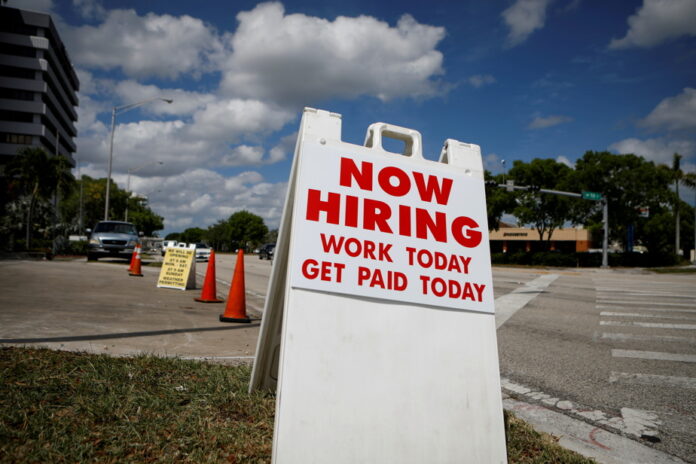(Washington) The job market remained solid in June in the United States, with job creations remaining strong, even if they were below expectations, and an unemployment rate down slightly and remaining at historically low levels.
In the past month, 209,000 jobs have been created, the Labor Department announced on Friday, while analysts expected 220,000, according to the consensus published by Briefing.com.
Job creations for April and May have been revised downwards to 217,000 and 306,000 respectively, i.e., over the two months, 110,000 fewer jobs than initially announced.
“It’s a step in the right direction, but we’re clearly not at the level where we need to be to demonstrate that the job market is easing,” said the chief economist for the United States of ‘Oxford Economics, Oren Klachkin, interviewed by AFP.
Job creations remain driven by public administration, health and social assistance, as well as by construction, detailed the Department of Labor.
At the same time, the unemployment rate is down slightly from 3.7% in May to 3.6% in June, which was expected by analysts and has kept unemployment in the same range for more than a year. year and a half.
“The unemployment rate has been below 4% for 17 months, the longest streak since the 1960s. Inflation is falling, we are seeing sustained and stable growth. These are the effects of “Bidenomics””, welcomed in a press release the American president, Joe Biden, in reference to the plans for financing the economy launched since the beginning of his mandate.
But, a sign of the current slowdown in a market that is still particularly tight, the average number of jobs created per month over the first six months of the year is significantly lower than the average observed for the whole of year 2022 (respectively 278,000 versus 399,000 jobs on average).
However, this remains “a high level and it means more money in the pockets of consumers, when it is their spending that has so far supported the economy”, underlined in a commentary Robert Frick, economist for Navy Federal Credit Union. .
Especially since at the same time, the average hourly wage continued to increase, by 0.4% compared to the previous month and 4.4% over one year, slightly above market expectations, which were rather considering 0.3% increase over one month.
“Wages have remained at a potentially worryingly high level,” as signs of a slowdown are desperately awaited, HFE chief economist Rubeela Farooqi said in a note.
The labor market participation rate remained stable at 62.9% for the fourth month in a row.
On Thursday, the ADP/Stanford Lab monthly survey announced an unexpected level of job creation in the private sector for the month of June, with 497,000 jobs, well above forecasts, but also the trend observed in previous months, giving some cold sweats to the markets, the New York Stock Exchange having finished in the red.
On Thursday, Wall Street opened slightly lower following the jobs numbers.
“As it stands, as long as inflation doesn’t come down more sharply and the job market eases, everything points to a proactive stance” on the part of the Fed, Farooqi said.
“The signals are mixed,” nuanced Mike Fratantoni, chief economist for MBA, “industrial activity remains weak, but consumer spending is holding up. We still expect the economy to slow in the second half.”
The Fed has embarked on a more restrictive monetary policy since March 2022 in order to reduce inflation and bring it back to its target of 2%, but the American economy has been stronger than initially envisaged and inflation more persistent than expected.
While the Fed paused at its last meeting in mid-June, its chairman Jerome Powell anticipated two further rate hikes by the end of the year.
In May, inflation stood at 3.8% year on year, according to the PCE index published at the end of June, the lowest since mid-2021, but still too high for the Fed.















